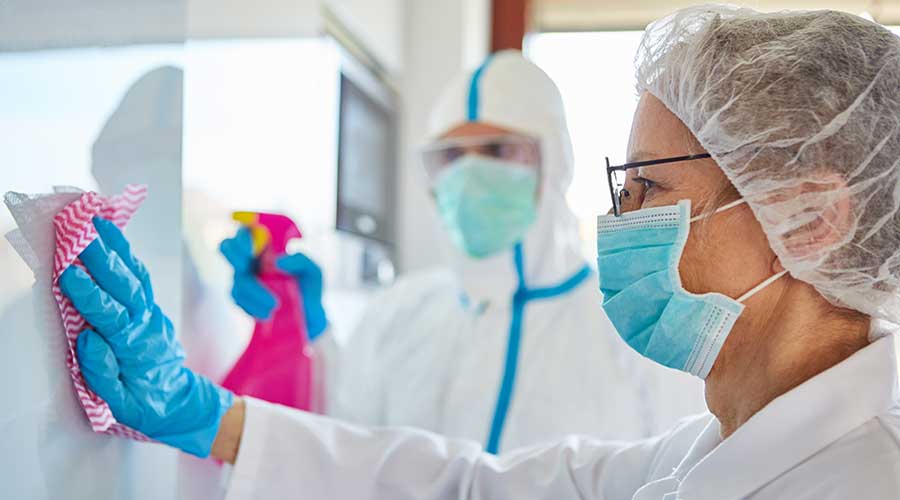Microfiber cleaning products are not rags. They have become essential and valuable tools for delivering disinfectants to environmental surfaces in hospitals and other healthcare facilities. But these scientifically engineered wiping and mopping microfiber products are only as good as the person who uses them, and their performance depends on the way they are laundered and stored.
Tackling biofilm
Pathogenic organisms on healthcare surfaces do not remain as isolated and free-floating life forms. They communicate and colonize with other germs to build a tough, protective biofilm that can withstand even the strongest disinfectants.
Biofilm protects itself with a tough film that must be broken up by agitating the surface to which it is attached. Professional environmental services (EVS) staff using a microfiber wiper and a scrubbing motion can disrupt the biofilm and remove it.
Microfiber helps physically remove the food and moisture necessary for micro-organisms to survive, but better grades of microfiber with very dense weaving configuration can even remove large quantities of microbes, including hard-to-kill spores. The guiding principle is always to remove germs if possible, and then use the least toxic or corrosive disinfectant to kill the survivors.
Microfibers: A closer look
Microfiber’s magic is purely mechanical. All cleaning towels woven from natural or synthetic fibers work the same way. The fibers absorb liquid, while the spaces and holes in the weave pattern and along fiber surfaces catch and hold dirt. The more spaces and grooves, the more dirt the fabric can hold.
Microfiber excels at cleaning due to the thinness of its fibers. One hundred microfibers are the thickness of one human hair. Makers of advanced microfibers go further, shredding the fibers to create even more dirt-trapping power. Fabrics woven from advanced microfibers contain millions of holes and grooves that can trap 100 times more dirt than a cotton towel.
One caveat: Some microfiber products should not be used with quaternary disinfectants due to the quat-binding effect. If quats are used in an operation, workers must be sure to test microfiber in the presence of the disinfectant to ensure the pH of the disinfectant is maintained.
Laundering microfibers
Microfiber is available as single-use — monofilament, polyester — or as durable or launderable — bicomponent, polyester plus polyamide. But controversy exists over the efficacy of reprocessed microfiber. Microfiber reprocessing should align with the 2003 CDC laundry guidelines: Machine wash at 160 degrees for 25 minutes with 50-150 ppm bleach, and dry at low heat setting of 130 degrees.
It is important to note that current CDC guidance cautions that chlorine-based disinfectants such as bleach can damage microfibers. Managers should purchase microfibers whose manufacturer indicates that bleach can be used “as necessary” — think C-diff spore killing — for hot-water laundering and “is required” for cold water laundering.
The performance of microfiber products is crucial, given the widespread use of durable microfiber and the critical need to ensure the effective removal of pathogenic organisms from patient care surfaces. These cleaning tools should remain clean and protected before they are used on potentially contaminated surfaces. The health and safety of patients and staff depend on the efficacy of microfiber products in the hands of educated and trained ES professionals.
J. Darrel Hicks, BA, MESRE, CHESP, Certificate of Mastery in Infection Prevention, is the past president of the Healthcare Surfaces Institute. Hicks is a nationally recognized subject matter expert in infection prevention and control as it relates to cleaning. He is the owner and principal of Safe, Clean and Disinfected. His enterprise specializes in B2B consulting, webinar presentations, seminars and facility consulting services related to cleaning and disinfection. He can be reached at darrel@darrelhicks.com. Learn more at www.darrelhicks.com.

 The Fatal Flaws in Active Shooter Response in Healthcare Facilities
The Fatal Flaws in Active Shooter Response in Healthcare Facilities Utah Hospital Outage Highlights Backup Power and Resiliency Challenges
Utah Hospital Outage Highlights Backup Power and Resiliency Challenges Ground Broken on New North Dakota State Hospital
Ground Broken on New North Dakota State Hospital Form Your Pit Crew: Key Takeaways From the 2025 Healthcare Innovations Conference
Form Your Pit Crew: Key Takeaways From the 2025 Healthcare Innovations Conference Glens Falls Hospital Caught Up in Oracle Health Data Breach
Glens Falls Hospital Caught Up in Oracle Health Data Breach